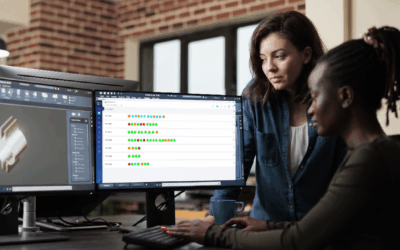Introduction
Not all data are normally distributed. There are many different possible distributions. It’s a common belief in the world of quality engineering that if data isn’t normally distributed, you can’t apply control charts because normality is a requirement to apply control charts. Turns out, this belief doesn’t hold up – and in this blog we will explain why.
What is the Normal Distribution Curve?
A normal distribution – also known as a bell curve, Gaussian distribution, or Gauss distribution – is a continuous probability distribution that is bell-shaped and symmetric around the mean. It is the most widely used probability distribution in statistics.
In a normal distribution, approximately 68.27% of the data falls within one standard deviation of the mean, 95.45% of the data falls within two standard deviations, and 99.73% of the data falls within three standard deviations.

Normal Distribution in Statistical Process Control
The usage of the normal distribution has roots going back nearly a century. When Statistical Process Control was first introduced in the 1920s by Walter Shewhart, many of the tools we still use today, like X̄ and R charts, were built on assumptions tied to the normal (Gaussian) distribution.
A statistic often used in quality control is the average of multiple samples. A known concept in probability theory is the Central Limit Theorem. The Central Limit Theorem states that the sampling distribution of the averages approaches a normal distribution as the size of the sample increases, regardless of the shape of the original population distribution. The central limit theorem was first established in a specific case by Abraham de Moivre in 1733, and then generalized and proven in a more general form by Pierre-Simon Laplace in 1810, who is often credited with its overall discovery and demonstration of its importance in probability theory.
Shewhart used this theorem and established that placing control limits at three standard deviations from the process mean — in both directions — offered a practical balance between the risk of reacting to a false alarm and the risk of not reacting to a true signal. (Economic Control of Quality of Manufactured Product, 1931)
SPC uses control charts to monitor data points and identify when a process deviates from its expected normal behavior, indicating potential issues. When a statistic does follow a normal distribution, about 99.7% of data points are expected to fall within three standard deviations of the mean. When a measurement is found outside the 3 sigma limits we assume there is a special cause of variation. That means there’s only a 0.3% chance (or 1 in 370) of a measurement value beyond 3 standard deviations and there is not a special cause of variation.
Although the central limit theorem is applicable it is not a requirement for using control charts.
There are areas in statistics where normality is required. For example if you apply hypothesis testing then specific tests require normality. For example if you use the F- and t-test the data should be normally distributed.
Also if you report about capability you use the 99.7 % of the variation in the calculation. If your data is not normally distributed you might get a slight deviation if you assume the data is normally distributed. In case of heavy tails in the distribution you might need to apply the non normal capability calculation.
Somehow over the years this normality requirement in hypothesis testing and capability also resulted in the misconception that normality is required for control charts.
So why is normality not required?
The Three-Sigma Rule Works (Even for Non-Normal Data)
If normality were truly required, range charts wouldn’t work because they are never normally distributed— yet they’ve been used for decades and continue to be highly effective.
While statistical tests like the t-test and F-test do require a normal distribution, SPC on the shop floor is not about hypothesis testing. It’s about answering a more practical question: Is my process stable or not? And the good news is, SPC can still give you valuable insights even when your data isn’t normally distributed.
Experts like Donald Wheeler (Advanced Topics in Statistical Process Control) have shown for decades that it is a myth that control charts work because of the central limit theorem. SPC is built to handle real-world scenarios.
In fact, Wheeler’s findings – supported by earlier work from Irving Burr, who analyzed 27 different non-normal distributions – demonstrate that control charts remain reliable even with data that show extreme skewness (over 1.9) or kurtosis (above 12) because in every distribution more than 99% of the measurements lay between the 3 sigma limits. The core principle still holds: when using three-sigma limits, the chance of a false alarm (a point falling outside the limits due to common cause variation) remains low – less than 1% – regardless of the underlying distribution.
That’s good news for those of us who don’t live in textbook conditions.

Working with Non-Normal Data: Practical Tips That Work
In hypothesis testing, it’s recommended to transform data so it meets the assumption of normality.
But if your goal is to use control charts to monitor process stability, transforming your data can do more harm than good. Operators may struggle to understand the variation in transformed values, and as a result, the control charts can lose practical meaning. Unless you’re performing formal statistical tests, we strongly recommend keeping the data in its original form.
Most of the cases you don’t need to transform your data or look for a perfect distribution match.
Here’s how to handle non-normality in practice:
- Individuals control chart: This is often the simplest option. However, be cautious with zone-tests when your data is heavily skewed or non-normal. These tests may produce false alarms. Still, using the traditional ±3σ limits works well. The few points that fall outside those limits are often due to real special causes.
- Use X̄ & R charts: You need to have a rational method of subgrouping the data, but it is one way of reducing potential false signals from non-normal data. The Central Limit Theorem helps normalize the distribution of averages, even when individual data points aren’t normal.
- For capability analysis you can use the Non-normal Capability NCpk: This requires SPC software. The software will apply fitting to all kind of different distributions and establish the best fit. Based on the distribution the capability will be calculated based on the 99.85% percentile – 0.15% percentile.


In Qualis SPC 4.0, you can use the “skewed bounded distributions” and NCpk options to use the specific distribution models to be used to determine the best fit curve and calculate the non normal capability.
Conclusion: Focus on Process Signals, Not Distributions
All that being said and demonstrated, we can be sure that we don’t need the data to follow a normal distribution to keep your process in control. Donald Wheeler’s insights show that effective SPC is about understanding process behavior. By shifting focus from strict assumptions to special causes of variation recognition, you get:
- Better control;
- Fewer false alarms;
- A clearer picture of what’s really happening.
Instead of worrying about normality, invest your energy in:
- Identifying real process signals;
- Training teams to understand variation;
- Focusing on what the data is trying to tell you.
As Dr. Wheeler puts it: “The shape of the histogram doesn’t determine your process control, your signals do.”
So if your data isn’t textbook-perfect? Don’t worry. Control charts weren’t made for textbooks, they were made for the shop floor.
By adopting Wheeler’s principles, you gain a more practical, intuitive way to keep processes stable and improve continuously. The key is to trust what your data tells you!
Discover how DataLyzer and our Qualis 4.0 SPC software can help you to implement Statistical Process Control that works in practise. Our team of experts is ready to show you how our web-based solution can be tailored to your needs.



